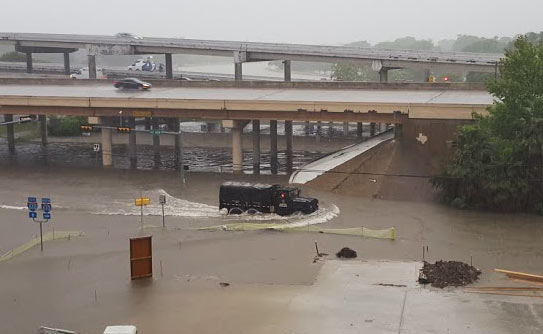JUST HOW MUCH FLOODING IS TOO MUCH FLOODING FOR HOUSTON?  We pretty much know what we would have to do to stop most Houston flooding, writes Dylan Baddour as the calendar flips to 2017.  Potential paths to drier ground for the city include a multitude of complex region-wide tasks, including changes to waterways across the county, adding thousands of acres of detention space, and potentially addressing the cumulative impacts of seemingly minor small-scale building practices.  The cost of upgrading the whole system, including buyouts, bayou widenings, and utility rerouting, is estimated by the county flood control folks at around $27 billion — and that’s just to get protection up to so-called 100-year storm levels; Houston has had 8 such storms in the past 27 years, and the Tax Day flood was fueled by a much larger event. “What needs to be decided,” Baddour writes, “is how far taxpayers are willing to go. Cars don’t have airbags to absorb a hit from a train. Should Houston have a drainage system to contain a biblical storm? Where does the city draw the line?” City flood czar Steve Costello tells Baddour that the city has to do something, however, to avoid passing on a “potentially insurmountable problem” to future Houstonians. [Houston Chronicle] Photo of N. Braeswood Dr. at 610 on April 17, 2016: Chris Klesch
We pretty much know what we would have to do to stop most Houston flooding, writes Dylan Baddour as the calendar flips to 2017.  Potential paths to drier ground for the city include a multitude of complex region-wide tasks, including changes to waterways across the county, adding thousands of acres of detention space, and potentially addressing the cumulative impacts of seemingly minor small-scale building practices.  The cost of upgrading the whole system, including buyouts, bayou widenings, and utility rerouting, is estimated by the county flood control folks at around $27 billion — and that’s just to get protection up to so-called 100-year storm levels; Houston has had 8 such storms in the past 27 years, and the Tax Day flood was fueled by a much larger event. “What needs to be decided,” Baddour writes, “is how far taxpayers are willing to go. Cars don’t have airbags to absorb a hit from a train. Should Houston have a drainage system to contain a biblical storm? Where does the city draw the line?” City flood czar Steve Costello tells Baddour that the city has to do something, however, to avoid passing on a “potentially insurmountable problem” to future Houstonians. [Houston Chronicle] Photo of N. Braeswood Dr. at 610 on April 17, 2016: Chris Klesch





If our cars were hit by trains multiple times each year, we’d figure out some way to reduce the damage.
There is this thing called Flood Insurance. As far as I know(andI am an insurance agent), every community in Harris and the surrounding counties participates in NFIP. All homeowners, renters and businesses are eligible to purchase flood insurance. There is no cure for flooding, any more than there is a cure for fire or windstorm. But you can insure. Stop wringing your hands and just buy the effing insurance.
You either pay for the fixes or let residents continue to be subjected to higher insurance premiums, maintenance and rebuild costs slowly depriving the city of tax revenue. At some point, property values will appreciate to the point where making the fixes may have been the smart thing to do. Not saying it’s financially practical of course.
.
What was the property damage total for the past 2 years of flooding though?
I revise my comment from December 8. There is no 100 year flood plain or 100 year flood. There is something, in the flood insurance business, called Base Flood one percent. What that means is that there is a one percent chance of flooding or less. In different terms, probability is less than or equal to point 01.
Assuming a point 009 probability(just less than one percent) a home still has a twenty percent chance of flooding, at least once, over the course of a thirty year mortgage(look up binomial probability if you want to know the mathy part.). An alternative way to think about the odds, is that one in five homes, in the base flood one percent area, will actually flood over the course of a thirty year mortgage.
After having explained this, it should surprise no one that “Houston has had 8 such storms in the past 27 years.” In theory, every year should bring some flooding, to at least some homes in the Houston area, even the homes in so-called “100 year flood plain.”
@Jardinero1: If we do nothing to reduce the cost of flooding, eventually flood insurance won’t be economically viable. All of that money has to come from somewhere. The complicated part is figuring how much to spend reducing risk up front and how much to spend dealing with it later. But from the Meyerland area, it sure looks like we aren’t doing enough to reduce risk up front.
City / County leadership wants to propose billion dollar bailouts from the Fed Government to distract that hundreds of millions of dollars to be used for flooding projects are being gobbled up by the city patronage system also known as the TIRZ system.
Why are we trying to fix Houston in order for it to not flood? This city is ecological set up to flood every time it rains. It is flat low absobsortion earth near a major body of water in a subtropical climate. I figure that’s why we get hurricanes too. 🤔 But why get mad at the damage flooding does and build the way we live conducive to where we live. You see the houses of 5th Ward/Heights/Trinity Gardens majority lifted with bricking with ditches in front of every yard. 😮NO FLOODING? Even 3rd Ward/Gleenbrook/Eastwood extremely raised lots with raised foundations and deep streets to channel water. No Flooding! Build like we’re in the Bayou city and embrace the high waters we chose to live here it’s not changing for us. And it’s actually cheaper in the beginning and extremely so in the long run!
The non area cognizant building came in the late 60s when the first MPN came about just outside of 610 such as Oak Forest and Meyerland and majority inner SW neighborhoods. They weren’t built wisely to be bisected by prominent bayous. But they probably figured the bayou was to prevent flooding. It just mitigates and manages but no bayou was made (naturally or man) to stop flooding.
I always check the Harris County Flood Education mapping tool before making any home purchases and steer clear of anything remotely near any floodplain.
http://www.harriscountyfemt.org/Index.aspx
No flooding in the Heights? Not even on White Oak? Shady Acres is pretty much all in the flood, notice how even the crap town homes are built up there?
@houcynic – urban flooding occurs regardless of whether you are in a flood plain or not.
@ Memebag: If our cars were hit by trains multiple times each year, we’d figure out that the way to reduce the damage – may be to move out of the vicinity of the trains. In this analogy, people would be moved/banned from being in the path of the train (flood).
.
But, It is unreasonable to think that we can have all 3 million people in the metro area move to higher ground. It makes sense that multiple solutions have to be used: better building/higher elevations, better drainage, flood insurance premiums being priced correctly, and strict “no build” zones in the worst flooding areas. I don’t have the proportional mix of these factors but there is no one “magic bullet”.
I live in the Heights and had a car flooded on the street when the storm sewers backed up. You can insure all day and all night, but flooding is still a substantial and devastating interruption in your life. Even with excellent and super-responsive auto insurance, it took a lot of time and effort to total out the car, deal with the rental and shop for a new vehicle. Having a home flooded out will generally mean at least six months of dealing with repairs, rentals, contractors, storage, moving companies, buying replacements. And that presumes that the insurance claim process goes through without a hitch and there is enough cash on hand to cover deductibles and other expenses. If the flooding of the past two years becomes a “new normal”, people will eventually get fed up with the disruptions and leave the city. Add in a few hurricanes and it becomes hard to justify Houston’s heat, humidity and traffic to potential new residents.
The Federal flood insurance program operates in the red, so taxpayers in effect subsidize the rebuilding of flood prone areas. This artificially lowers the risk of home ownership. Flood insurance should become privitized to let those who live in flood prone areas realize the true cost. People will get the idea and move elsewhere.
Never said the neighborhoods don’t flood, I am saying the design of the infrastructure and homes prevents homes in that area from taking on water.